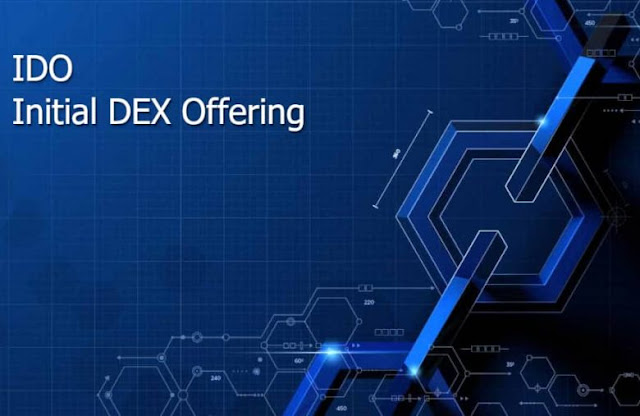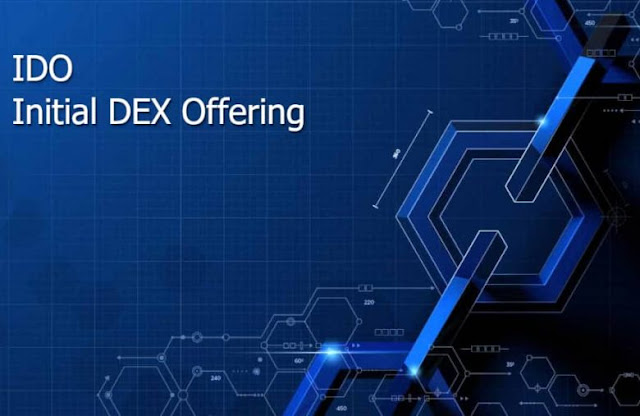Why Initial DEX Offering Matters
A new way to invest in innovative crypto businesses is gaining traction, and it might become the de facto mechanism for projects to fund their growth. Initial DEX Offerings (IDOs) have a lot of promise, and they provide a far better way for the average individual to get involved in new crypto ventures than past ways. We'll go over the various techniques of generating cash, their benefits and drawbacks, and why IDOs are swiftly becoming the decentralized fundraising model of the future.
A Complete Comparison of IDO, IEO, and ICO
Fundraising is one of the most crucial steps in the development of an innovative firm. In comparison to a startup that does not collect money, fundraising allows the founders to get capital, develop their product, and grow substantially faster.
A project, particularly a crypto project, can raise funds in a variety of methods. An IPO, or initial public offering, is the most traditional way outside of the crypto world. In a nutshell, the corporation trades capital for shares, or equity in the company. While this is a viable method of raising funds, many early-stage companies are wary about enlisting more partners and relinquishing too much control. Initial Coin Offerings (ICO), Initial Exchange Offerings (IEO), and the most promising approach, Initial DEX Offerings, are all viable options for crypto companies looking to generate capital and fuel growth while maintaining flexibility (IDO).
What Is An Initial Coin Offering (ICO)?
An initial coin offering (ICO) was the first and most popular method of generating funds for crypto companies. Projects do not want to give up equity in their project, as previously indicated. Instead, the blockchain-based firm sells tokens, which have built-in utility or provide access to the project's platform or service. Early investors buy these tokens in the hopes that the firm will develop and flourish, increasing the value of their token.
How does an investor decide which ICO to back? When the ICO is launched, a whitepaper is issued that contains information on the project's objective, use case, and schedule. This is how the company defines its mission and markets its value in order to have a successful ICO.
An ICO can go in one of three directions. The first is to have a set supply and pricing. The number of coins or tokens available remains constant, as does the price per token. When a project has a clear purpose in mind, this is usually done. The second option is to keep the supply fixed but allow for a dynamic price range, with funding determining the overall cost per coin or token. The final option is to set a fixed price while keeping supply dynamic, such that funding ultimately determines supply.
Advantages
Convenience of participation - For both the token issuer and the investor, the ease of participating in an ICO attracts a wide range of investors and reaches a broader audience than an IPO.
No equity loss - The project team is not forced to give up any equity in their idea in order to receive funding, which is commonly necessary for businesses in their early stages.
The community is incentivized to advocate for and support their project by issuing tokens; everyone has a vested interest in the project's success.
Disadvantages
There are no guarantees or protections for investors because ICOs are not regulated, therefore there are little to none in the event of a scam or technical failure.
Legal Issues - Many nations, including China, France, Russia, and Thailand, have either severely limited or outright outlawed initial coin offerings. The Securities and Exchange Commission (SEC) in the United States is cracking down on ICOs, which might be seen as securities and so be subject to numerous US regulations. ICOs are unfavorable to investors and entrepreneurs looking to raise funds through an ICO because of their unclear future.
Scam danger- Due to their unregulated nature, ICOs have a high possibility of being scammed, and the investor bears the entire risk.
There isn't much transparency between the consumer and the token issuer - In the ICO process, there isn't much transparency or assurances beyond what the token issuer and project declare in their whitepaper.
The initial coin offering (ICO) model is far from flawless. In fact, because of the numerous downsides, particularly the significant risk of scams, ICOs are no longer used to fund crypto initiatives.
What Exactly Is An IEO?
The IEO arose as a result of the ICO's eventual demise. An IEO is similar to an ICO, but with one key difference: the token sale is facilitated by an exchange. The exchange evaluates the whitepaper, the team, the tokenomics, and a variety of other factors to ensure that the crypto project applying for an IEO is authentic.
As a result, those asking for an IEO are usually further along in their development and have a minimum viable product (MVP) to pitch to investors. In a nutshell, the exchange acts as a go-between for investors and token issuers, reducing the risk associated with an IC.
Advantages
Because an exchange helps the IEO, it does not wish to have any scams on its platform. As a result, each project that applies for an IEO is carefully scrutinized. When it comes to investing in a project, this provides investors with some security and piece of mind.
Measures to Know Your Customer and Anti-Money Laundering - Unlike an ICO, measures to Know Your Customer and Anti-Money Laundering give security to both parties.
The user experience in an IEO is typically significantly more frictionless because the exchange assists the transaction and marketing.
Disadvantages
centralized - One of the most appealing aspects of blockchain technology is its decentralized nature, whereas an IEO is the polar opposite. Many crypto enthusiasts and investors desire the advantages of decentralization, such as transparency and anonymity.
Only available to users of the exchange - To participate in an IEO, investors must first register as users on that exchange. This may limit the project's audience and financial opportunities.
Fees - Because the exchange invests time and resources in the verification process, projects must often pay a high price to launch an IEO. For most startups, this was just not an option.
The Increasing Popularity Of Initial DEX Offerings (IDO)
An IDO is one of the most current and promising ways for projects to receive funding. An IDO is a token offering that takes place on a decentralized exchange.
What Is An IDO and How Does It Work?
To allow the transfer of tokens and payments between parties, IDOs first relied on decentralized exchanges (DEX) and smart contracts. Since then, they've mainly been held on dedicated platforms known as IDO launchpads. These launchpads assist to limit the risk of huge crypto wallets (also known as whales) buying a substantial percentage of an IDO's tokens.
In comparison to ICOs and IEOs, the transfer of funds for tokens on an IDO launchpad is swift and painless. As a result, money are not delayed, and investors typically receive immediate liquidity. Furthermore, rather than a centralized exchange, the vetting process for an IDO on a launchpad is done cooperatively by the team and community, which benefits investors and boosts security.
What Are the Benefits of Having an IDO?
Decentralized - Unlike ICOs and IEOs, IDOs use blockchain technology to facilitate transactions, making them far more transparent and safe.
Projects that are vetted - IDOs that are hosted on a DEX are still reviewed, but by the community rather than the exchange. IDOs that are hosted on an IDO launchpad are typically evaluated by the team and/or a special counsel, as well as the community.
IDOs avoid the hefty expenses associated with launching an IEO and listing on an exchange, making them more affordable and accessible to companies.
Safer - IDOs are considerably less likely to be hacked than centralized exchanges because they do not keep funds.
Listed right away - IDO has the advantage of being instantaneous, which means both parties have immediate access to their funds/tokens. However, vesting periods are frequently tied to the tokens gained by IDO members, so make sure you read the rules before participating.
What Are the Drawbacks of Having an IDO?
No stable pricing - While IDO provides investors with immediate access. This accessibility (especially quickly after launching) might cause the token's price to be extremely erratic.
Market Manipulation - When new tokens become available for trading, there is always the risk of "pump and dumps". The token's value is artificially raised before a large number of tokens are sold off. That is why it is critical to select an IDO or an IDO platform with care.
What Does the IDO Model's Future Hold?
IDO has a number of advantages over the ICO and IEO models, and it takes full advantage of blockchain technology. Centralized exchanges are more widely available and far more user-friendly for the new crypto traders. A couple of things must happen for IDO to become a popular fundraising technique. First and foremost, IDO must be user-friendly and easily accessible. The general population will become more aware of cryptocurrencies and blockchain technology as they become more widely used. This will make it easier for new investors to get into the space and participate in IDOs.
Fortunately, the rise of the IDO launchpad has made IDOs more accessible and user-friendly. An IDO launchpad is a specialized platform where entrepreneurs can get their start (thus the name) and crowdfund their investment. Launchpads are easier to use, have their own community, and are frequently accompanied by their own utility coin. Startups are approved through the launchpad, and then the community can invest in new crypto initiatives.
IDO Launchpad by Scaleswap
While IDO launchpads are redefining decentralized financing and are now part of practically every new project's go-to-market strategy, there are still some problems to iron out in terms of fairness and entrance barriers for newcomers.
Through a loyalty-based rating system for its users, Scaleswap wants to remove these barriers and promote fairness and transparency. ScaleSCORE is a multidimensional scoring system that empowers consumers based on their commitment. They are having the least influence on their actual purchasing power. Scaleswap makes it possible for everyone.
This benefits the projects that are launching on the platform since they can tap into this carefully nurtured network. It helps them bootstrap growth and boost their launch plan.
How to Purchase Tokens Using the IDO Launchpad
So you've heard about IDOs, but how do you become involved? IDO launchpads, not decentralized exchanges, now host the majority of IDOs. As a result, you must often become "whitelisted" by a launchpad, which entails deciding to participate in future IDOs. Each launchpad has its own set of rules and procedures for becoming whitelisted.
While some launchpads focus solely on financial criteria to determine participation, others, such as Scaleswap's ScaleSCORE, evaluate loyalty and commitment. Additionally, individuals that own the launchpad's utility token often receive more entries into the competition. You can now purchase tokens for that IDO, and the launchpad will most likely email you the necessary details.
Conclusion
Over the last few years, the way crypto projects raise funds has changed dramatically. Every step of the journey saw greater investor protection. It reduced the chance of scams, and a better overall experience for all parties involved. IDO launchpads arose from the emergence of decentralized financing via IDOs. They currently provide a secure, simple, and seamless approach to engage in IDOs. IDO launchpads embody and support decentralization, which is the future of cryptocurrency as a whole. IDOs and IDO launchpads are the future of fundraising because of this.



Comments
Post a Comment